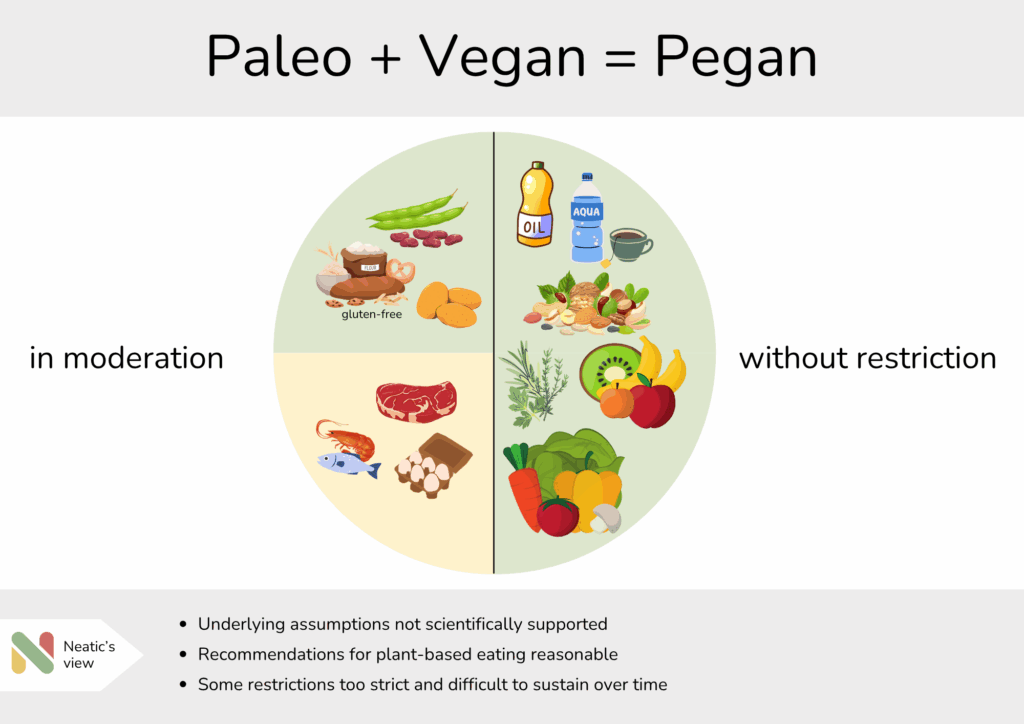
Major points:
- The word “pegan” is derived from “paleo” and “vegan”. Those who follow a pegan diet combine both approaches.
- The pegan diet consists of 75% plant-based and 25% animal-based foods.
- Neatic considers the theory behind the pegan diet to be scientifically unsupported and finds some of its restrictions of food choices neither beneficial nor sustainable in the long term.
What does pegan mean?
The term “pegan” is a blend of “paleo” and “vegan.” Those who follow a pegan diet incorporate elements from both dietary approaches.
The pegan diet was developed by the American physician Mark Hyman. His goal was to combine the health benefits of both the paleo and vegan diets while allowing more flexibility in everyday life compared to following either diet strictly.
The pegan diet does not rigorously adhere to either the paleo or vegan guidelines. Instead, it focuses on selecting unprocessed foods, which should be 75% plant-based and 25% animal-based.
In this way, the pegan diet closely resembles a plant-based approach that emphasizes maximizing the intake of unprocessed plant-based foods while not completely eliminating animal products.
Principles of the pegan diet
The pegan diet follows these eight key principles:
1. Meat, fish, and eggs are side dishes.
The main part of a meal should consist of plant-based foods, with meat, fish, and eggs serving only as a side dish. Additionally, it is important to prioritize ethically sourced animal products.
2. Choose healthy fats.
Healthy fats in the pegan diet are those rich in omega-3 fatty acids, such as those found in nuts, avocados, flaxseed oil, walnut oil, and fatty fish like salmon, herring, or mackerel. In contrast, omega-6 fatty acids, present in vegetable oils such as sunflower or soybean oil, should be avoided.
3. Eat nuts and seeds every day.
Nuts and seeds provide protein, healthy fats, and make you feel sated. According to Mark Hyman, consuming a handful of nuts daily has only positive effects on health.
4. Avoid milk and dairy products.
This recommendation applies specifically to cow’s milk and dairy products made from it. Those who do not want to give up dairy can consume products made from sheep’s or goat’s milk or opt for plant-based alternatives such as nut-based or oat-based drinks, as long as they do not contain added sugars.
5. Prefer foods with a low glycemic load.
The glycemic load measures how a carbohydrate-rich food affects blood sugar levels. The pegan diet advises avoiding sugar whenever possible. Carbohydrates should primarily come from whole grain products, which contain fiber that slows the rise in blood sugar.
6. Avoid gluten.
Gluten is a collective term for proteins found in grains and grain-based products such as bread and pasta. According to Mark Hyman, gluten is suspected of causing digestive discomfort and potentially contributing to autoimmune diseases in some individuals. Therefore, the pegan diet focuses on gluten-free grains such as rice, quinoa, and gluten-free substitutes.
7. Consume legumes in moderation.
Legumes such as peas, lentils, and beans are a good source of protein. However, they can be difficult to digest for some people and should therefore be eaten in moderation based on individual tolerance.
8. Prefer natural sweetness from fruits.
Sugar, syrup, honey, and sweeteners such as artificial sweeteners are not permitted in the pegan diet. Sweet cravings should be satisfied primarily with fruits or dried fruits, as long as they do not contain added sugars.
Health benefits
The main goal of the pegan diet is to regulate blood sugar levels. This is intended to help prevent cravings and reduce the risk of type 2 diabetes. Additionally, it is believed to have anti-inflammatory properties and is sometimes recommended for conditions such as rheumatoid arthritis and osteoarthritis.
By eliminating sugar and focusing on whole foods, the pegan diet may be lower in calories than a typical mixed diet, potentially supporting weight loss.
What does science say?
There are currently no scientific studies evaluating the pegan diet or its potential health benefits.
However, several studies suggest that a plant-based diet is associated with a lower risk of cardiovascular diseases and type 2 diabetes. This may be because plant-based diets are often lower in calories, which reduces the risk of obesity.
It is important to note, however, that a plant-based diet is not automatically healthy. If ultra-processed foods make up the majority of one’s diet, a plant-based approach offers no particular health advantages.
Several studies have found links between consuming ultra-processed foods and an increased risk of obesity, cardiovascular disease, dementia, and gastrointestinal disorders, as well as a shorter lifespan.
What does Neatic recommend concerning the pegan diet?
A positive aspect of the pegan diet is that it indirectly aligns with Neatic principles by avoiding ultra-processed foods, sugar, and sweeteners. Another advantage is that fruit consumption is not restricted, allowing sweet cravings to be satisfied with natural options, as recommended by Neatic.
However, the exclusion of cow’s milk and dairy products is questionable. These foods provide essential protein and calcium, and unless an individual has an intolerance, there is no scientific reason to avoid them.
The avoidance of gluten-containing grains is also a point of concern. The trend of eliminating gluten has gained popularity, particularly in the United States. However, there is no scientific evidence suggesting that a gluten-free or gluten-reduced diet offers health benefits unless an individual has celiac disease or a wheat allergy.
Unlike the pegan diet, Neatic does not restrict grains, milk, or dairy products. Additionally, Neatic does not impose limits on legume consumption, as legumes have been a fundamental part of the human diet for centuries.
The beneficial aspects of the pegan diet are also incorporated into Neatic. However, by focusing on three principles backed by scientific research, Neatic remains far more flexible for everyday life. Social gatherings, eating out, or simply managing daily challenges do not result in stress or an increased risk of falling back into old eating habits.
If you are interested in the pegan diet, you might also be interested in these diets.
Bibliography
German Nutrition Society (2023): Selected questions and answers on plant-based nutrition. Available online at https://www.dge.de/gesunde-ernaehrung/faq/pflanzenbasierte-ernaehrung/#c6063, checked on 1/10/2024.
Mark Hyman (2024): Why I am a Pegan – or Paleo-Vegan – and Why You Should Be Too! Available online at https://drhyman.com/blog/2014/11/07/pegan-paleo-vegan/, checked on 1/10/2024.
Verbraucherzentrale.de (2023): Gluten-free food: Booming market | Verbraucherzentrale.de. Available online at https://www.verbraucherzentrale.de/wissen/lebensmittel/kennzeichnung-und-inhaltsstoffe/glutenfreie-lebensmittel-boomender-markt-10939, checked on 1/10/2024.
Verbraucherzentrale.de (2023): Glycemic index (GI) and glycemic load (GL) | Verbraucherzentrale.de. Available online at https://www.verbraucherzentrale.de/wissen/lebensmittel/schlankheitsmittel-und-diaeten/glykaemischer-index-gi-und-glykaemische-last-gl-11176, checked on 1/10/2024.
